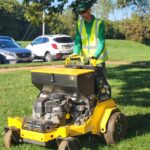 By Cate Deane, Training & Development Manager
By Cate Deane, Training & Development Manager
As the vibrant colors of summer begin to fade, your lawn, courtyard, sports field, or other turf areas might be showing signs of wear and tear from the season’s activities. This makes fall the opportune time for revitalizing your turf. For those in the Mid-Atlantic region, fall offers more consistent soil temperatures—ideally around 60 degrees—which allow optimal growing conditions for turf grasses. In this article, we’ll explore the ins and outs of turf renovation, highlighting its pivotal components and the steps to take post-renovation for enduring, lush results.
What does a turf renovation entail?
 Aeration is the process of creating holes in the soil throughout turf areas to break up soil that’s compacted—which is often an unintended consequence of foot traffic, play, and various outdoor activities. These holes serve as conduits for water, oxygen and other essential nutrients to reach deeper into the soil profile so that the turf can generate new and deeper roots.
Aeration is the process of creating holes in the soil throughout turf areas to break up soil that’s compacted—which is often an unintended consequence of foot traffic, play, and various outdoor activities. These holes serve as conduits for water, oxygen and other essential nutrients to reach deeper into the soil profile so that the turf can generate new and deeper roots.- Overseeding is the process of seeding on top of existing turf to increase turf density, introduce improved grass variety, and enhance the color of the turf. This is typically performed after immediately following aeration so that seeds can fall into the holes created and reach the root zone. When overseeding, you can also fill in bare spots or target problem areas.
- Top dressing involves the application of a new, thin layer of organic material on top of turf areas to increase the nutritional sustainability of the soil. Again, this is usually performed immediately after aeration to take advantage of the better access to deep root zones. The choice of organic material is versatile and adaptable to your turf’s unique requirements, whether it’s nutrient-rich topsoil, organic compost, well-draining sand, or a tailor-made blend, the top dressing adds a dynamic layer of nourishment. Armed with the insights from a comprehensive soil test, our experts can accurately prescribe the specific amendment your site and soil type demand. This precision ensures that your turf’s foundation is optimized for growth and long-lasting vitality.
What happens after?
Upon completion of a turf renovation, our landscape maintenance crews follow a carefully adjusted watering and mowing schedule to support the best possible results:
- Watering:
- Water in the morning vs. late afternoon or night, so as not to encourage fungus or disease
- In the first month, water with less volume, but more frequency to keep the ground moist without washing away seedlings
- In the second month and beyond, once seeds have germinated, water less frequently but in larger volumes to fully saturate the soil and encourage deep root growth
- Mowing:
- Do not mow while grass is germinating; wait until it’s at least four inches high
- Let the turf area dry out for at least a day before mowing
- Adjust mowers to a higher mowing height to avoid scalping
- Resume normal mowing schedule around four weeks out from renovation
Additionally, we recommend coning off the treated area to reduce pedestrian, vehicle, or equipment traffic as much as possible during germination—a period of at least one month.
As the leaves begin to fall and the temperatures gradually dip, your property’s turf has a golden opportunity to reclaim its vitality with a thorough renovation. Aeration, overseeding, and top dressing are the tools we wield to rejuvenate your turf, ensuring it survives the colder months and comes back lush and healthy in the spring. Let this fall be the season your turf truly shines – reach out to your dedicated area manager today to schedule an estimate to explore the transformative possibilities of turf renovation.
 Aeration is the process of creating holes in the soil throughout turf areas to break up soil that’s compacted—which is often an unintended consequence of foot traffic, play, and various outdoor activities. These holes serve as conduits for water, oxygen and other essential nutrients to reach deeper into the soil profile so that the turf can generate new and deeper roots.
Aeration is the process of creating holes in the soil throughout turf areas to break up soil that’s compacted—which is often an unintended consequence of foot traffic, play, and various outdoor activities. These holes serve as conduits for water, oxygen and other essential nutrients to reach deeper into the soil profile so that the turf can generate new and deeper roots.